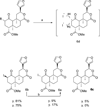Synthesis and biological evaluation of C-2 halogenated analogs of salvinorin A
- PMID: 20801035
- PMCID: PMC4514444
- DOI: 10.1016/j.bmcl.2010.08.001
Synthesis and biological evaluation of C-2 halogenated analogs of salvinorin A
Abstract
Salvinorin A (1), the main active ingredient of Salvia divinorum, is a potent and selective κ opioid receptor (KOPR) agonist. Based on the SAR, its C-2 position is one of the key binding sites and has very little space tolerance (3-4 carbons atoms) and limited to only lipophilic groups. In our attempt to prepare PET brain imaging agent for mapping KOPR, a series of C-2 halogenated analogs have been synthesized and screened for binding affinity at κ (KOPR), μ (MOPR), and δ (DOPR). These C-2 halogenated analogs with sequential changes of atomic radius and electron density serve as excellent molecular probes for further investigating the binding pocket at C-2, particularly on the effects of α verses β configuration at C-2 position. The results of KOPR binding and functional studies reveal β isomer in general binds better than α isomer with the exception of iodinated analogs and none of the C-2 halogenated analogs shows any improvement of KOPR binding affinity. Interestingly, functional assay has characterized that 6b is a partial agonist with E(max) of 46% of the kappa receptor full agonist U50,488H at 250 nM (K(i)). We have also observed that the affinity to the kappa receptor increases with atomic radius (I>Br>Cl>F) which is in good agreement with halogen bonding interactions reported in the literature.
Copyright © 2010. Published by Elsevier Ltd.
Figures




Similar articles
-
Synthesis and biological evaluation of C-12 triazole and oxadiazole analogs of salvinorin A.Bioorg Med Chem Lett. 2009 Mar 1;19(5):1301-4. doi: 10.1016/j.bmcl.2009.01.078. Epub 2009 Feb 9. Bioorg Med Chem Lett. 2009. PMID: 19211245
-
Modification of the furan ring of salvinorin A: identification of a selective partial agonist at the kappa opioid receptor.Bioorg Med Chem. 2009 Feb 1;17(3):1370-80. doi: 10.1016/j.bmc.2008.12.012. Epub 2008 Dec 14. Bioorg Med Chem. 2009. PMID: 19147366 Free PMC article.
-
Differential signaling properties at the kappa opioid receptor of 12-epi-salvinorin A and its analogues.Bioorg Med Chem Lett. 2012 Jan 15;22(2):1023-6. doi: 10.1016/j.bmcl.2011.11.128. Epub 2011 Dec 7. Bioorg Med Chem Lett. 2012. PMID: 22204910 Free PMC article.
-
Salvinorin A analogs and other κ-opioid receptor compounds as treatments for cocaine abuse.Adv Pharmacol. 2014;69:481-511. doi: 10.1016/B978-0-12-420118-7.00012-3. Adv Pharmacol. 2014. PMID: 24484985 Free PMC article. Review.
-
Chemical syntheses of the salvinorin chemotype of KOR agonist.Nat Prod Rep. 2020 Nov 18;37(11):1478-1496. doi: 10.1039/d0np00028k. Nat Prod Rep. 2020. PMID: 32808003 Free PMC article. Review.
Cited by
-
Natural Products for the Treatment of Pain: Chemistry and Pharmacology of Salvinorin A, Mitragynine, and Collybolide.Biochemistry. 2021 May 11;60(18):1381-1400. doi: 10.1021/acs.biochem.0c00629. Epub 2020 Sep 22. Biochemistry. 2021. PMID: 32930582 Free PMC article. Review.
-
Solving an Old Puzzle: Elucidation and Evaluation of the Binding Mode of Salvinorin A at the Kappa Opioid Receptor.Molecules. 2023 Jan 11;28(2):718. doi: 10.3390/molecules28020718. Molecules. 2023. PMID: 36677775 Free PMC article.
-
Kappa-opioid receptor-selective dicarboxylic ester-derived salvinorin A ligands.Bioorg Med Chem Lett. 2013 May 15;23(10):2860-2. doi: 10.1016/j.bmcl.2013.03.111. Epub 2013 Apr 4. Bioorg Med Chem Lett. 2013. PMID: 23587424 Free PMC article.
-
Potential Drug Abuse Therapeutics Derived from the Hallucinogenic Natural Product Salvinorin A.Medchemcomm. 2011 Dec;2(12):1217-1222. doi: 10.1039/C1MD00192B. Medchemcomm. 2011. PMID: 22442751 Free PMC article.
-
A review of salvinorin analogs and their kappa-opioid receptor activity.Bioorg Med Chem Lett. 2018 May 15;28(9):1436-1445. doi: 10.1016/j.bmcl.2018.03.029. Epub 2018 Mar 12. Bioorg Med Chem Lett. 2018. PMID: 29615341 Free PMC article. Review.
References
Publication types
MeSH terms
Substances
Grants and funding
LinkOut - more resources
Full Text Sources
Chemical Information
Research Materials
Miscellaneous

